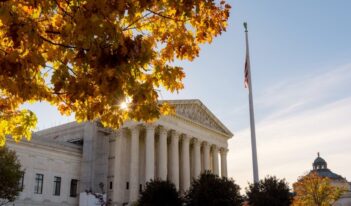
Congress faces issues in attempting to apply regulation-removing law to agency guidance.
Congress’s use of the Congressional Review Act (CRA) to reverse a panoply of Obama Administration rules has been the most important way it has pursued deregulation in the first year of the Trump Administration. But the effort to keep using it to deregulate—which is ongoing—would really take the statute beyond anywhere it has been used before.
The CRA provides a streamlined legislative process for overturning rules adopted in opposition to the legislature’s wishes. Congress last used the tool to reverse a rule adopted by the Consumer Financial Protection Bureau (CFPB) that would have allowed consumer class actions against banks.
The most important facet of the act for regulators is that, once used, it “salts the earth.” No “substantially similar” rule can be subsequently adopted by regulators once Congress has reversed a rule under the CRA. The CFPB, for example, will no longer be able to adopt another, even somewhat different, consumer class action rule without getting legislative approval.
The problem with the CRA, at least for deregulation mavens, is that it has a narrow window. Congress can only use the statute for rules adopted in the prior 60 “legislative days,” that is, days when Congress is in session.
Those 60 days have passed for Obama Administration rules. That means that the 14 times that Congress used the CRA at the beginning of the Trump Administration—and it had only been used once before that, to reverse an Occupational Health and Safety Administration rule promulgated at the end of the Clinton Administration—were thought to be the end of this particular deregulatory strategy for this Administration.
When the CFPB adopted its consumer class action rule last summer, we saw that the act could still be used to reverse a recently adopted rule—but it is revealing that in that instance the rule had been issued by an independent agency that was, at the time, still headed by an Obama appointee. With the passage of time and the departure of former CFPB Director Richard Cordray, the prospects for using the CRA to repeal independent agencies rules seemed to grow increasingly dim.
But with help from the U.S. Government Accountability Office (GAO), one senator, Pat Toomey (R-Pa.), has sought to expand the use of the CRA to reach way back into 2013 to guidance offered by banking regulators. Toomey’s effort to expand the use of the CRA process to reach agency action that happened long ago, so that Congress need not go through regular order to reverse agency rules, is unconvincing.
Rules require notice, comment, and judicial review. To avoid these requirements, agencies sometimes issue guidance instead, since guidance can be offered with none of those features. Guidance does serve a valuable function, though, when it tells industry what the agency is driving at with regard to how the agency understands already promulgated rules and laws.
Guidance is controversial when it sets the parameters for agency enforcement in a definitive way—which means everything for regulatory compliance—without providing the industry with recourse to the courts. Guidance is not substantive or final agency action, or so the agency will tell you as it moves to dismiss any lawsuit complaining about a memo.
Senator Toomey asked GAO to look at some guidance materials covering the way regulators treat leveraged lending to see if that guidance should have been promulgated as a rule.
GAO concluded that the leveraged lending guidance issued in 2013 by the Federal Reserve, the Federal Deposit Insurance Corporation, and the Comptroller of the Currency is subject to the CRA. It said that any “general statement of policy would appear to fit squarely within this definition of a rule subject to CRA,” and then GAO specifically concluded that the leveraged lending guidance fit the bill.
Under both the CRA and the Administrative Procedure Act, a rule is defined as “the whole or a part of an agency statement of general or particular applicability and future effect designed to implement, interpret, or prescribe law or policy or describing the organization, procedure, or practice requirements of an agency.”
GAO found that the guidance was “a general statement of policy designed to assist financial institutions in providing leveraged lending to creditworthy borrowers in a sound manner. As such, it is a rule subject to the requirements of CRA.”
Agencies do not usually think of general statements of policies as rules, and Congress explicitly exempted those statements from the notice and comment rulemaking requirements long ago.
Moreover, the 2013 guidance is very different from the rules that Congress reversed last year under the CRA, which were promulgated after notice and comment and were designed to impose legally binding requirements on regulated industry. The leveraged lending guidance purports not to impose any binding requirements.
So, one problem with GAO’s decision is that, even under a very broad definition of a rule, it is not clear that the guidance, which was not meant to create legal obligations, was “designed” to “prescribe law or policy.” It does not look like it was describing the “procedure or practice requirements” of the regulators either, although it was offering the industry a view of the agency’s enforcement priorities.
Yet even if the guidance does count as a general statement of policy designed to prescribe law or policy—and this is by no means clear—that does not quite get Congress to the point at which it could use the CRA to repeal it. The CRA makes clear that congressional resolutions to reverse a rule under the law cannot be passed until an agency sends the rule to Congress. That means that Congress cannot act on the leveraged guidance until it is sent over by the agencies—and the agencies presumably have never done so, because they did not think they were promulgating a rule.
These problems aside, GAO has given some members of Congress with a deregulatory zeal a rationalization for treating the 2013 guidance as something that should have been subject to congressional review and that could still be reviewed now.
That might mean that members of Congress could try to use the CRA to reverse still other guidance passed long ago, and that they might try to treat the window for the CRA to be as long as Congress chooses it to be, in order to take advantage of the expedited CRA process. As we have seen, though, guidance is not easily transformed into something appropriate for the CRA.
Of course, even though industry often favors deregulation, there are reasons for banks to be wary of a congressional effort to reverse the leveraged loan guidance. Because of the CRA’s salt-the-earth affect, were the 2013 guidance to be reversed under the CRA, bank regulators could say virtually nothing about leveraged lending, whether by guidance or by rule. They would, however, continue to have their broader safety and soundness powers, which they could interpret in any enforcement action to conclude that a bank is engaging in risky lending practices.
Overall, if Congress removed the lending guidance, the only way banks would be able to see if their regulators had a problem with their leveraged lending programs would be to implement those programs and hope that an enforcement action does not follow.
Such a change would make life hard for the banks, but the bigger point is that if the argument takes hold that any guidance can be targeted for disapproval under the CRA, provided that it has not already been sent over for Congress, that would mean some policymakers might be able to find ways to try to keep the deregulatory good times rolling.
It is difficult, however, to see how they can pull that off in a manner consistent with a proper understanding of the status of guidance in the regulatory state.




